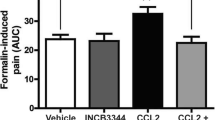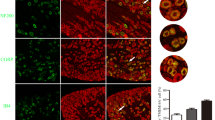Abstract
Peripheral inflammation and nerve injury usually accompany each other. However, whether inflammatory and neuropathic pain share similar mechanisms at all stages is unknown. TRPV1 and P2X3 are two major ion channels in dorsal root ganglia (DRGs) and are involved in chronic pain. Here, their function and expression in DRGs at different phases of the two types of pain were investigated. Both the paw withdrawal threshold (PWT) and paw withdrawal latency were decreased in rats injected with complete Freud’s adjuvant (CFA). However, only the PWT was decreased in rats with spared nerve injury (SNI). CFA increased the magnitude of the TRPV1-mediated Ca2+ response but not the P2X3-mediated Ca2+ response 14 days after injection. Consistent with this result, the P2X3 expression level in CFA rats was increased only at 3 days after injection. SNI surgery increased the magnitudes of the TRPV1- and P2X3-mediated Ca2+ responses and upregulated both TRPV1 and P2X3 expression in lumbar DRGs. The distributions of TRPV1 and P2X3 in DRGs after modeling were observed, and TRPV1 was found to be highly expressed mainly in the L4–L5 DRGs in CFA rats and in the L5–L6 DRGs in SNI rats. P2X3 was highly expressed in the L4–L6 DRGs in CFA rats 3 days after injection but was only highly expressed in the L4 DRG 14 days after modeling. On the other hand, SNI promoted the P2X3 expression L4–L5 DRGs 3 days after surgery, but only L6 DRG 14 days after modeling. All the results indicate that P2X3 and TPRV1 are involved in inflammatory and neuropathic pain by different expression levels and distributions in the lumbar DRG in the chronic stage.






Similar content being viewed by others
Code availability
Not applicable.
Availability of data and material
The datasets used and/or analyzed during the current study are available from the corresponding author on reasonable request.
Abbreviations
- P2X3:
-
P2X purinoceptor 3
- DRG:
-
Dorsal root ganglion
- TRPV1:
-
Transient receptor potential cation channel subfamily V member 1
- CAP:
-
Capsaicin
- SNI:
-
Spared nerve injury
- CFA:
-
Complete Freund’s adjuvant
- PWT:
-
Paw withdrawal threshold
- PWL:
-
Paw withdrawal latency
- CPZ:
-
Capsazepine
References
Bernier LP, Ase AR, Seguela P (2018) P2X receptor channels in chronic pain pathways. Br J Pharmacol 175:219–230. https://doi.org/10.1111/bph.13957
Brandt MR, Beyer CE, Stahl SM (2012) TRPV1 Antagonists and chronic pain: beyond thermal perception. Pharmaceuticals (Basel, Switzerland) 5:114–132. https://doi.org/10.3390/ph5020114
Burnstock G (2000) P2X receptors in sensory neurons. Br J Anaest 84:476–488
Burnstock G (2016) Purinergic mechanisms and pain. Adv pharmacol (San Diego, Calif) 75:91–137. https://doi.org/10.1016/bs.apha.2015.09.001
Büttner R et al (2018) Inflammaging impairs peripheral nerve maintenance and regeneration. Aging Cell 17:e12833–e12833. https://doi.org/10.1111/acel.12833
Chaplan SR, Bach FW, Pogrel JW, Chung JM, Yaksh TL (1994) Quantitative assessment of tactile allodynia in the rat paw. J Neurosci Methods 53:55–63. https://doi.org/10.1016/0165-0270(94)90144-9
Chen Y, Li GW, Wang C, Gu Y, Huang LY (2005) Mechanisms underlying enhanced P2X receptor-mediated responses in the neuropathic pain state. Pain 119:38–48. https://doi.org/10.1016/j.pain.2005.09.007
Chen L et al (2016) Differential expression of ATP-gated P2X receptors in DRG between chronic neuropathic pain and visceralgia rat models. Purinergic Signal 12:79–87. https://doi.org/10.1007/s11302-015-9481-4
Cruccu G, Truini A (2017) A Rev Neuro From Guide Clin Pain Thera 6:35–42. https://doi.org/10.1007/s40122-017-0087-0
Du X et al (2017) Local GABAergic signaling within sensory ganglia controls peripheral nociceptive transmission. J Clin Investig 127:1741–1756. https://doi.org/10.1172/jci86812
Fattori V, Pinho-Ribeiro FA, Staurengo-Ferrari L, Borghi SM, Rossaneis AC, Casagrande R, Verri WA (2019) The specialized pro-resolving lipid mediator Maresin-1 reduces inflammatory pain with a long-lasting analgesic effect. Br J Pharmacol. https://doi.org/10.1111/bph.14647
Fukuoka T, Tokunaga A, Tachibana T, Dai Y, Yamanaka H, Noguchi K (2002) VR1, but not P2X in the spared L4 DRG in rats with L5 spinal nerve ligation. Pain 99:111–120
Gonzalez-Rodriguez S (2019) In Vivo methods to study ThermoTRP channels in rodents. Methods Mole Biol (Clifton, NJ) 1987:223–231. https://doi.org/10.1007/978-1-4939-9446-5_14
Hirai T et al (2014) Intrathecal AAV serotype 9-mediated delivery of shRNA against TRPV1 attenuates thermal hyperalgesia in a mouse model of peripheral nerve injury. Mole Ther J Am Soc Gene 22:409–419. https://doi.org/10.1038/mt.2013.247
Hudson LJ, Bevan S, Wotherspoon G, Gentry C, Fox A, Winter J (2001) VR1 protein expression increases in undamaged DRG neurons after partial nerve injury. Eur J Neurosci 13:2105–2114
Hung CY, Tan CH (2018) TRP channels in nociception and pathological pain advances in experimental. Med Biol 1099:13–27. https://doi.org/10.1007/978-981-13-1756-9_2
Jung YH et al (2017) Discovery of potent antiallodynic agents for neuropathic pain targeting P2X3 receptors ACS. Chem Neurosci 8:1465–1478. https://doi.org/10.1021/acschemneuro.6b00401
Kage K, Niforatos W, Zhu CZ, Lynch KJ, Honore P, Jarvis MF (2002) Alteration of dorsal root ganglion P2X3 receptor expression and function following spinal nerve ligation in the rat. Exp Brain Res 147:511–519. https://doi.org/10.1007/s00221-002-1263-x
Kan HW, Chang CH, Lin CL, Lee YC, Hsieh ST, Hsieh YL (2018) Downregulation of adenosine and adenosine A1 receptor contributes to neuropathic pain in resiniferatoxin neuropathy. Pain 159:1580–1591. https://doi.org/10.1016/j.bja.2018.01.016
Kwon SG et al (2014) Blockade of peripheral P2Y1 receptors prevents the induction of thermal hyperalgesia via modulation of TRPV1 expression in carrageenan-induced inflammatory pain rats: involvement of p38 MAPK phosphorylation in DRGs. Neuropharmacology 79:368–379. https://doi.org/10.1016/j.neuropharm.2013.12.005
Leisengang S et al (2020) Effects of gabapentinoids on responses of primary cultures from rat dorsal root ganglia to inflammatory or somatosensory stimuli. J Basic Clin Physiol pharmacol 1:31. https://doi.org/10.1515/jbcpp-2019-0261
Li Y et al (2019) Electroacupuncture alleviates paclitaxel-induced peripheral neuropathic pain in rats via suppressing TLR4 signaling and TRPV1 upregulation in sensory. Neurons Internat J Mole Sci 1:20. https://doi.org/10.3390/ijms20235917
Liu CK, Liao WT, Chu YC, Yang CH, Chen KH, Wu CH, Lin CR (2017) Pulsed radiofrequency attenuates complete Freund’s adjuvant-induced epigenetic suppression of potassium chloride cotransporter two expression pain. Medicine (Malden, Mass) 18:807–813. https://doi.org/10.1093/pm/pnw243
Liu C, Li C, Deng Z, Du E, Xu C (2018) Long non-coding RNA BC168687 is involved in TRPV1-mediated diabetic neuropathic pain in rats. Neuroscience 374:214–222. https://doi.org/10.1016/j.neuroscience.2018.01.049
Luo J et al (2018) Zinc Inhibits TRPV1 to alleviate chemotherapy-induced neuropathic pain the journal of neuroscience: the official. J Soc Neurosci 38:474–483. https://doi.org/10.1523/jneurosci.1816-17.2017
Magni G, Ceruti S (2014) The purinergic system and glial cells: emerging costars in nociception. BioMed Res Internat 4:495789. https://doi.org/10.1155/2014/495789
North RA (2016) P2X receptors philosophical transactions of the royal society of London series B. Biological sciences. https://doi.org/10.1098/rstb.2015.0427
Nunez-Badinez P et al (2018) Variable transcriptional responsiveness of the P2X3 receptor gene during CFA-induced inflammatory hyperalgesia. J Cell Biochem 119:3922–3935. https://doi.org/10.1002/jcb.26534
Patel KV, Guralnik JM, Dansie EJ (2011) Turk DC (2013) Prevalence and impact of pain among older adults in the United States: findings from the. National Health Aging Trends Study Pain 154:2649–2657. https://doi.org/10.1016/j.pain.2013.07.029
Premkumar LS (2014) Transient receptor potential channels as targets for phytochemicals ACS. Chem Neurosci 5:1117–1130. https://doi.org/10.1021/cn500094a
Schafers M, Geis C, Svensson CI, Luo ZD, Sommer C (2003) Selective increase of tumour necrosis factor-alpha in injured and spared myelinated primary afferents after chronic constrictive injury of rat sciatic nerve. Eur J Neurosci 17:791–804
Shields SD, Eckert WA 3rd, Basbaum AI (2003) Spared nerve injury model of neuropathic pain in the mouse: a behavioral and anatomic analysis. J Pain Off Am Soc 4:465–470
Sommer C, Leinders M, Üçeyler N (2018) Inflammation in the pathophysiology of neuropathic pain. Pain 159:595–602. https://doi.org/10.1097/j.pain.0000000000001122
Sondermann JR et al (2019) Vti1b promotes TRPV1 sensitization during inflammatory pain. Pain 160:508–527. https://doi.org/10.1097/j.pain.0000000000001418
Souza GR, Talbot J, Lotufo CM, Cunha FQ, Cunha TM, Ferreira SH (2013) Fractalkine mediates inflammatory pain through activation of satellite glial cells. Proc Natl Acad Sci USA 110:11193–11198. https://doi.org/10.1073/pnas.1307445110
Straube S, Derry S, Moore RA, Cole P (2013) Cervico-thoracic or lumbar sympathectomy for neuropathic pain and complex regional pain syndrome. Cochrane Database Syst Rev 1:002918. https://doi.org/10.1002/14651858.CD002918.pub3
Teixeira JM, Bobinski F, Parada CA, Sluka KA, Tambeli CH (2017) P2X3 and P2X2/3 receptors play a crucial role in articular hyperalgesia development through inflammatory mechanisms in the knee joint experimental synovitis molecular. Neurobiology 54:6174–6186. https://doi.org/10.1007/s12035-016-0146-2
Viana F (2018) Nociceptors: thermal allodynia and thermal pain. Handbook Clin Neurol 156:103–119. https://doi.org/10.1016/b978-0-444-63912-7.00006-0
Warwick CA, Shutov LP, Shepherd AJ, Mohapatra DP, Usachev YM (2019) Mechanisms underlying mechanical sensitization induced by complement C5a: the roles of macrophages, TRPV1, and calcitonin gene-related peptide receptors. Pain 160:702–711. https://doi.org/10.1097/j.pain.0000000000001449
Wu JX, Yuan XM, Wang Q, Wei W, Xu MY (2016) Rho/ROCK acts downstream of lysophosphatidic acid receptor 1 in modulating P2X3 receptor-mediated bone cancer pain in rats. Mole Pain 12:26–27. https://doi.org/10.1177/1744806916644929
Xiang Z et al (2008) Functional up-regulation of P2X 3 receptors in the chronically compressed dorsal root ganglion. Pain 140:23–34. https://doi.org/10.1016/j.pain.2008.07.006
Xiang H et al (2017) Primary sensory neuron-specific interference of TRPV1 signaling by AAV-encoded TRPV1 peptide aptamer attenuates neuropathic pain. Mole Pain 13:1744806917717040. https://doi.org/10.1177/1744806917717040
Xiong W et al (2017) Inhibitory effects of tetramethylpyrazine on pain transmission of trigeminal neuralgia in CCI-ION rats. Brain Res Bull 134:72–78. https://doi.org/10.1016/j.brainresbull.2017.07.005
Yezierski RP, Hansson P (2018) Inflammatory and neuropathic pain from bench to bedside: what went wrong? J Pain Off Am Pain Soc 19:571–588. https://doi.org/10.1016/j.jpain.2017.12.261
Zhang YL et al (2018) Microencapsulated Schwann cell transplantation inhibits P2X2/3 receptors overexpression in a sciatic nerve injury rat model with neuropathic pain. Neurosci lett 676:51–57. https://doi.org/10.1016/j.neulet.2018.03.063
Zhou YL et al (2015) Enhanced binding capability of nuclear factor-kappaB with demethylated P2X3 receptor gene contributes to cancer pain in rats. Pain 156:1892–1905. https://doi.org/10.1097/j.pain.0000000000000248
Funding
This work was supported by the National Natural Science Foundation of China (8147377, 81603690, 81603692), the Zhejiang Provincial Natural Science Foundation [China] (LY19H270003) and the Talent Project of the Zhejiang Association for Science and Technology (2017YCGC004).
Author information
Authors and Affiliations
Contributions
Ju. F., J. D. and Ji. F. conceived the presented study. Ju. F., Ji. F., J. D., X. X., X. H. and Y. J. designed and carried out the experiments. Y. L. and X. S. verified the analytical methods. B. L. and J. F. supervised the project.
Corresponding author
Ethics declarations
Conflict of interest
The authors declare that they have no competing interests.
Ethics approval
In the current study, all animal manipulation complied with institutional and Chinese governmental regulations regarding the ethical use of animals (approval no. IACUC-20180319–12).
Consent to participate
Not applicable.
Consent for publication
Not applicable.
Additional information
Communicated by Sreedharan Sajikumar.
Publisher's Note
Springer Nature remains neutral with regard to jurisdictional claims in published maps and institutional affiliations.
Supplementary Information
Below is the link to the electronic supplementary material.
Rights and permissions
About this article
Cite this article
Fang, J., Du, J., Xiang, X. et al. SNI and CFA induce similar changes in TRPV1 and P2X3 expressions in the acute phase but not in the chronic phase of pain. Exp Brain Res 239, 983–995 (2021). https://doi.org/10.1007/s00221-020-05988-4
Received:
Accepted:
Published:
Issue Date:
DOI: https://doi.org/10.1007/s00221-020-05988-4




